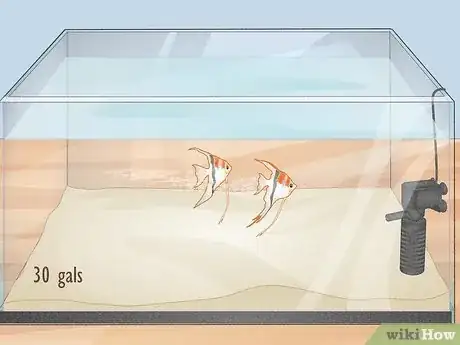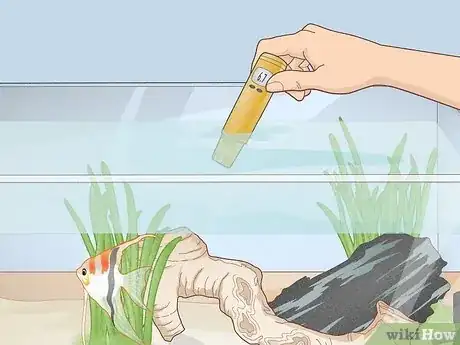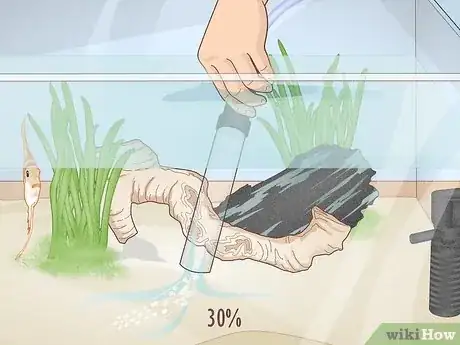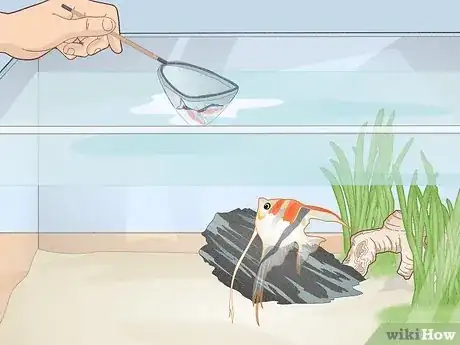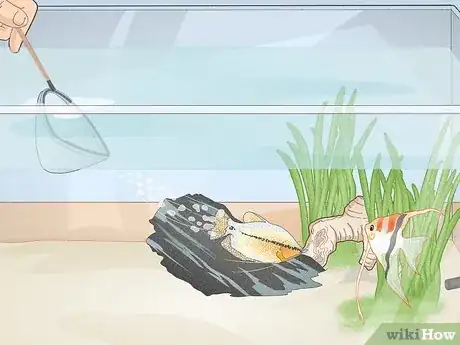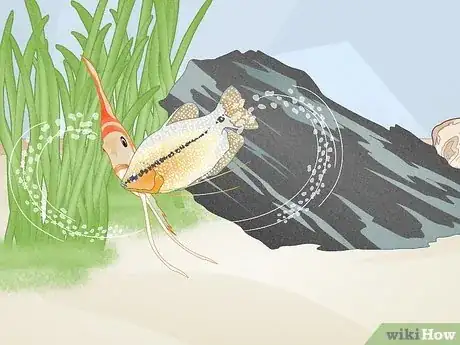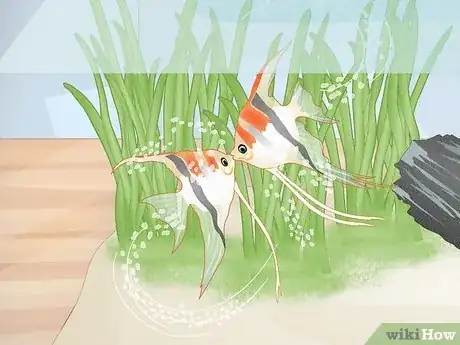This article was co-authored by Craig Morton and by wikiHow staff writer, Eric McClure. Craig Morton is the CEO of Aquarium Doctor Inc. based in Huntington Beach California and servicing Orange County, Los Angeles County, and the Inland Empire. With over 30 years of aquarium experience, Craig specializes in creating custom aquarium designs along with aquarium installation, service, and maintenance.
There are 15 references cited in this article, which can be found at the bottom of the page.
This article has been viewed 5,937 times.
Angelfish are beautiful additions to any freshwater tank, but they can be a little testy sometimes. If you’ve got an angelfish bullying others in your tank, it’s important to put an end to the behavior before any fish get hurt. Luckily, there are plenty of potential solutions to this problem. In this article, we’ll break down everything you need to know about putting an end to an angelfish’s bullying behavior so that you can keep your fish healthy and safe.
Steps
Give your fish a larger tank.
-
You need at least 30 gallons (110 L), but more is always better. If you’re seeing a lot of bullying behavior and your tank is smaller than 30 gallons (110 L), get a bigger tank and set it up. For a pair of angelfish alone, you need at least 30 gallons, although the more space you can give them the better. For a community tank, aim for a 50 US gal (190 L) tank or bigger.[1] X Research source
- If you’re keeping more than 2 angelfish, a good rule of thumb is to add 10 gallons after the first pair for each fish. So, you start at 30 gallons (110 L) for 2 angelfish. Then, you’d need a minimum of 40 gallons (150 L) for 3, 50 gallons (190 L) for 4, etc.[2] X Research source
- You can keep anywhere from 2-6 angelfish together in the same tank. If you only have 1 angelfish, at least keep other fish species in the tank—angelfish should never be entirely alone.[3] X Research source
- The taller the tank, the better. Angelfish are bottom swimmers, but they enjoy swimming vertical channels as well.
- It’s also harder for an angelfish to defend a big territory if their tank is very vertical, too. This makes taller tanks ideal for minimizing aggression.
Feed your fish enough food to fill them up.
-
A hungry angelfish will bully other fish for resources. Try feeding your fish slightly more food than you’d normally give them (if you can), or space their feedings out to feed the same amount just more frequently in smaller portions. This should calm any tempers around feeding time.[4] X Research source
- Angelfish require a mixed diet of commercial fish flakes or pellets, and frozen/dehydrated arthropods, like shrimp or mosquito larvae. If angelfish don’t get a healthy mix of food, they may become aggressive.[5] X Research source
- Feed your angelfish twice a day at the same time you feed their tankmates. In terms of the amount of food, it depends on how many fish you keep in the tank. Your angelfish should never take more than 2 minutes to finish their food, though. If you feed them and it takes them more than 1 minute but less than 2 minutes to eat, you’re giving them enough food.[6] X Research source
Add plants and rocks for other fish to hide.
-
Keep plenty of hiding spots for the other fish to run away. If you aren’t keeping an angelfish in a solitary tank, it’s bound to get into an occasional skirmish with other fish. When this happens, other fish need a place to run. Place a variety of rocky hideaways, aquatic plants, and/or decorative features in your tank for the other fish in your tank to flee.[7] X Research source
- An angelfish may chase off other fish who wander into their territory, but they should stop pursuing them once they run away and hide.
Set up a den near each angelfish’s territory.
-
Angelfish will become aggressive if they don’t have a hideout. Set a large plant, rock, or chunk of driftwood where your angelfish likes to peruse the water and hang out. Angelfish like to hide from competitors or if they’re overwhelmed by their tankmates. If you don’t give them a hiding spot, your angelfish will bully other fish out of frustration.[8] X Research source
- Don’t worry if your angelfish doesn’t take to the hiding spot right away. It can take some angelfish a while to get used to new features in their territory.
- Hiding is a natural behavior for angelfish. However, if your angelfish is hiding for extended periods of time, it might be a sign that your water quality is off and your angelfish is sick.
- If the fish is sick change the water and add aquarium salt.[9] X Research source
- It is the least harmful to fish and is effective in treating infections.[10] X Research source
Maintain a healthy water pH and temperature.
-
Angelfish will act out if the water isn’t comfortable for them. Angelfish may bully others if they’re irritated by their environment. Keep the water soft and slightly acidic. A pH level of 6.5-6.9 and a dH level of 0.6-1.2 is ideal. Maintain a water temperature of 75–82 °F (24–28 °C). Your angelfish may stop pestering or biting their tankmates if you fix their tank’s water.[11] X Research source
- You can change the temperature of the water by adjusting the dial on your aquarium’s water heater.
- Test your tank’s water using pH testing strips or a digital probe.
- If the tank’s pH level is too low, change the water out or add rocks and shells to slowly increase the pH.
- If the tank’s pH is too high, add driftwood or peat moss to naturally lower the pH in a sustainable way.
Change the water out less often with multiple angelfish.
-
With multiple angelfish, big water cycles are disruptive to the hierarchy. If you’re cycling and replacing 30% of the water every week, try dropping that to 20% every 2 weeks. Angelfish establish territories using chemicals and pheromones. When you replace a large percentage of the water, you can mess with those signals and throw the angelfish back into a squabble over turf.[12] X Research source
- Water changing can be a bit of an art when it comes to angelfish. Every school has their own distinct leaders, personalities, and hierarchies. It may take a bit of trial and error to figure out how much water you should cycle out and how often you should do it.
- When you buy new fishes do not put bag water into the aquarium.[13] X Research source
Rearrange everything in the tank.
-
Remove your fish and try “resetting” everything in the tank. Put your fish into temporary housing and drain the tank. Rinse all of the driftwood, plants, stones, and gravel, and then put everything back in a brand-new location. This will basically hit the reset button on the hierarchies and territories for your angelfish. If you’re lucky, the angelfish may find a more equitable, friendlier lay of the land.[14] X Research source
- This is the kind of thing you don’t want to too often. Totally cycling the water can be stressful for your fish.
Separate male angelfish in different tanks.
-
Males compete for territory and mates, so they tend to fight a lot. It is possible for two males to live together, but frankly, it’s rare. You’ve got to get very lucky when it comes to the personalities of the fish, and it will likely require a massive tank. If two males just won’t stop attacking one another, it’s time to split them up. Put the most problematic male in a brand new tank all by themselves.[15] X Research source
- If you’re new to angelfish or you haven’t set an aquarium up yet, stick exclusively with female angelfish. A school of female angelfish won’t fight or bully one another normally.
Remove smaller fish to keep them from being food.
-
Angelfish will eat any fish that can fit in their mouths. Angelfish are carnivores, and they regularly eat other fish in the wild. As a rule of thumb, if a fish fits in an angelfish’s mouth, the angelfish will eat it. Do not keep smaller fish in the tank with your angelfish. Even if nobody gets eaten, an angelfish may bully other fish to compete for the smaller fish they perceive as food.[16] X Research source
- Neon tetras in particular are natural food for angelfish. Other edible fish for an angelfish include rasboras and guppies.
- The one exception here is swordtails. Swordtails are tiny fish, but they’re just aggressive enough to put an angelfish in their place. In fact, they can even keep an angelfish from getting too aggressive.
Choose calm tank companions for the angelfish.
-
Non-aggressive fish of a similar size will minimize bullying behaviors. The presence of larger fish will keep angelfish from getting overconfident when it comes to defending their territory and fighting for food. Gouramis and other non-aggressive cichlids do well with angelfish, for example. The calmer and the bigger the fish, the better the tankmate![17] X Research source
- Other species that will do well alongside angelfish include catfish, plecos, and loaches.[18] X Research source
- If the angelfish is the smallest species in the tank, you’ve probably got a good tank composition going.
- Barbed fish and fin-nippers are no good alongside angelfish.
Let new tankmates fight for a day or two.
-
Angelfish use combat to establish territories and hierarchy. Angelfish are territorial, especially when they live alongside other angelfish. If you’ve just introduced a new fish, you’ve just brought your angelfish home, or you’ve cycled the water entirely, let the fish sort things out for themselves. Once the pecking orders and territories are established, the fighting may stop.[19] X Research source
- So long as nobody is losing any fins and the fish aren’t leaving marks on one another, don’t worry. Your fish will be fine.
- Normal angelfish combat should look a bit like dancing. They’ll face their opponent, swim back and forth rapidly to beat them with tail, and try “kissing” their opponent (biting them lightly). So long as they aren’t pursuing their opponents perpetually after they back down, it’s not a big deal.
Don’t mistake mating rituals for fighting.
-
It’s easy to confuse these two behaviors at a glance. If you have a male and a female angelfish, they will lock lips and flutter back and forth against one another when they’re about to mate. To many people, this looks like bullying. It’s not! Fighting involves nipping, chasing, and tail-flicking.[20] X Research source
- You might see some slightly aggressive behavior from the male angelfish after mating has taken place. Angelfish will usually eat their eggs in captivity unless you separate the breeding pair from tankmates and slightly overfeed them.[21] X Research source
- If two angelfish fight a little bit after fertilizing eggs, they’re probably competing over the food the eggs represent.
You Might Also Like

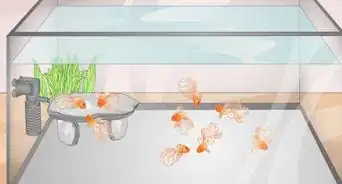 How Many Fish Can You Place in a Fish Tank?
How Many Fish Can You Place in a Fish Tank?







 How to Raise Salmon in a Pond (Your Top Questions Answered)
How to Raise Salmon in a Pond (Your Top Questions Answered)




References
- ↑ https://fishtankmaster.com/how-big-do-angelfish-get/
- ↑ https://www.petmd.com/fish/general-health/5-facts-about-angelfish
- ↑ https://fishkeepingguide.net/how-many-angelfish-should-be-kept-together/
- ↑ https://jaljeev.com/do-angelfish-eat-other-fish/
- ↑ https://www.petmd.com/fish/general-health/5-facts-about-angelfish
- ↑ https://www.aquariumnexus.com/feeding-angelfish/
- ↑ https://www.hartz.com/stress-in-fish-symptoms-and-solutions/
- ↑ https://www.justfishkeeping.com/do-angelfish-need-hiding-spots/
- ↑ https://www.petco.com/content/petco/PetcoStore/en_US/pet-services/resource-center/home-habitat/using-salt-in-freshwater-aquariums.html
- ↑ https://www.petco.com/content/petco/PetcoStore/en_US/pet-services/resource-center/home-habitat/using-salt-in-freshwater-aquariums.html
- ↑ https://animals.mom.com/angelfish-tank-requirements-4796.html
- ↑ https://www.science.org/content/article/angelfish-your-aquarium-getting-angry-try-changing-their-water-less-often
- ↑ https://www.hartz.com/how-to-introduce-new-fish-into-your-aquarium-tank/
- ↑ https://aquariumsathome.com/will-angelfish-kill-each-other/
- ↑ https://aquariumsathome.com/will-angelfish-kill-each-other/
- ↑ https://jaljeev.com/do-angelfish-eat-other-fish/
- ↑ https://fishtankmaster.com/how-big-do-angelfish-get/
- ↑ https://www.buildyouraquarium.com/angelfish-tank-mates/
- ↑ https://www.science.org/content/article/angelfish-your-aquarium-getting-angry-try-changing-their-water-less-often
- ↑ https://waterworldcraze.com/are-my-angelfish-fighting-or-mating/
- ↑ https://explorefishworld.com/why-angelfish-eat-their-eggs-and-how-to-prevent-it/
About This Article

